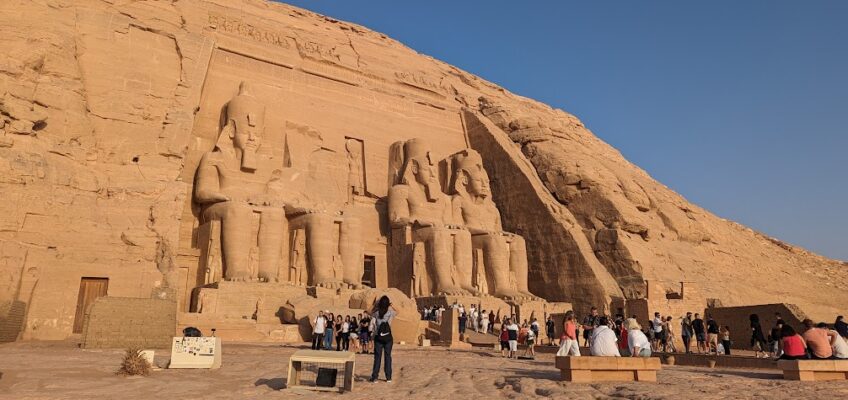I planned to write about Abu Simbel last night. But all the planning I did for this trip turned into a big snafu yesterday, as war broke out in Israel, and I spent the evening reworking all my plans.
I’ll write about that later. For now, I’m trying to stay positive, so I will focus on the visit to Abu Simbel.
Aswan to Abu Simbel
We said goodbye to our dehabeya and the terrific crew who took care of us on our five-day cruise up the Nile and boarded a bus to take us south. We drove through the city of Aswan and made our way to the High Dam. There really wasn’t a lot ot see there.
The High Dam was built between 1960 and 1970. It is one of the largest embankment dams in the world. An older dam, completed in 1902 was the largest masonry dam in the world at the time. But it was inadequate for irrigation needs and water supply as Egypt’s population grew. The High Dam, six kilometers upstream (south), has met those demands.
The dam created a large reservoir, Lake Nasser, that extends south from the dam for 300 kilometers, into northern Sudan. This displaced a large Nubian population, who have been resettled. It also required the relocation of twelve ancient temples to higher ground.
Nubia
After we got to our hotel in Abu Simbel (the charming Seti Hotel), we had a talk with Hussein Mokhtar, a Nubian scholar and author. He told us about the history and culture of the Nubian people. Unfortunately it was quite warm in the room, and we were all tired, so I don’t think I’m the only one who had a hard time staying focused.
One takeaway I got is that the Nubians are a people without a home. Those who were displaced when the High Dam was completed have been resettled, and they have full rights as citizens of Egypt, but they are not really Egyptian. And there is little hope for any change. People like him are doing what they can to keep the culture alive.
Sound and Light Show
That evening we visited the temples to see the sound and light show. This was a musical and visual extravaganza with a story about Ramses II and his wife Nefertari. I thought it was okay, and my sense was that most of the rest of the group were unimpressed. I expected lasers and brilliant lighting, but it was just projections with narration depicting some stuff about Ramses as a military leader and his love for Nefertari.
The best part was seeing the facades lit up in the night, and without hordes of people standing in front..
The temples at Abu Simbel
Abu Simbel is one of the sites that was relocated in the 1960s. Photographs at the visitor center tell an astonishing story. They had to dismantle the temples and raise them up, and they built new caves. The alignment of the temples is exactly as it was.
Ramses II built these two temples starting in 1264 BCE. They took about twenty years to complete.
We visited the Abu Simbel temples bright and early, before 8am, to avoid both the crowds and the heat of the day. As you will see from the photos below (and in my photo album), there were still a lot of crowds. And many more come down from Aswan for the day, arriving just as we were leaing.
The Great Temple
This temple is truly a monument to Ramses II himself as a great warrior. Walking through the Great Temple, the whole thing struck me as egotistical to the extreme. This was a man who must have derived great pleasure from the veneration of others. Not only do you have the four massive statues on the facade (one of which suffered damage in an earthquake shortly after construction), but this is what you see when you enter the temple:
Egomania aside, this temple astonished me. The artwork was magnificent and, for the most part, beautifully preserved.
The Small Temple
The Small Temple is, well, smaller than the Great Temple. It’s still pretty great. Built in honor of Nefertari, it is decidated to Hathor, the cow-goddess whose realms were beauty (including cosmetics), sensuality, music, dancing, and maternity.
After we visited the temples of Abu Simbel, we were back on the road, heading back to Aswan. But that’s a story for another day.
Be sure to check out all my photos from Abu Simbel, including the drive down.



Timothy Welch
Thank you!